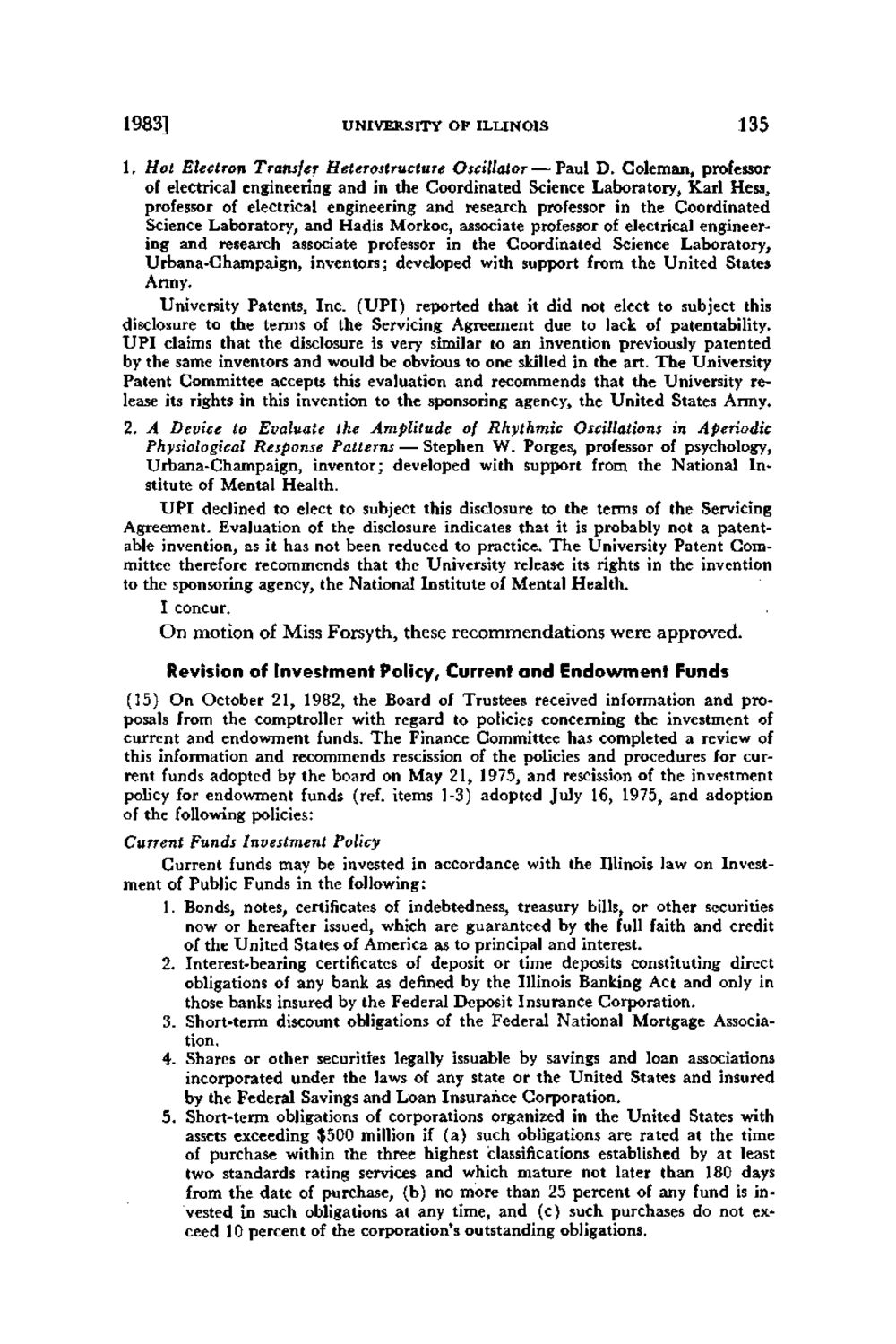| |
| |
Caption: Board of Trustees Minutes - 1984
This is a reduced-resolution page image for fast online browsing.

EXTRACTED TEXT FROM PAGE:
1983] UNIVERSITY OF ILLINOIS 135 1. Hot Electron Transfer Heterostructure Oscillator — Paul D . Coleman, professor of electrical engineering and in the Coordinated Science Laboratory, Karl Hess, professor of electrical engineering and research professor in the Coordinated Science Laboratory, and Hadis Morkoc, associate professor of electrical engineering and research associate professor in the Coordinated Science Laboratory, Urbana-Champaign, inventors; developed with support from the United States Army. University Patents, Inc. ( U P I ) reported that it did not elect to subject this disclosure to the terms of the Servicing Agreement due to lack of patentability. U P I claims that the disclosure is very similar to an invention previously patented by the same inventors and would be obvious to one skilled in the art. The University Patent Committee accepts this evaluation and recommends that the University release its rights in this invention to the sponsoring agency, the United States Army. 2. A Device to Evaluate the Amplitude of Rhythmic Oscillations in Aperiodic Physiological Response Patterns — Stephen W. Porges, professor of psychology, Urbana-Champaign, inventor; developed with support from the National Institute of Mental Health. U P I declined to elect to subject this disclosure to the terms of the Servicing Agreement. Evaluation of the disclosure indicates that it is probably not a patentable invention, as it has not been reduced to practice. T h e University Patent Committee therefore recommends that the University release its rights in the invention to the sponsoring agency, the National Institute of Mental Health. I concur. O n m o t i o n of Miss F o r s y t h , t h e s e r e c o m m e n d a t i o n s w e r e a p p r o v e d . Revision of Investment Policy, Current and Endowment Funds (15) On October 2 1 , 1982, the Board of Trustees received information and proposals from the comptroller with regard to policies concerning the investment of current and endowment funds. T h e Finance Committee has completed a review of this information and recommends rescission of the policies and procedures for current funds adopted by the board on May 21, 1975, and rescission of the investment policy for endowment funds (ref. items 1-3) adopted July 16, 1975, and adoption of the following policies: Current Funds Investment Policy Current funds may be invested in accordance with the Illinois law on Investment of Public Funds in the following: 1. Bonds, notes, certificates of indebtedness, treasury bills, or other securities now or hereafter issued, which are guaranteed by the full faith and credit of the United States of America as to principal and interest. 2. Interest-bearing certificates of deposit or time deposits constituting direct obligations of any bank as defined by the Illinois Banking Act and only in those banks insured by the Federal Deposit Insurance Corporation. 3. Short-term discount obligations of the Federal National Mortgage Association. 4. Shares or other securities legally issuable by savings and loan associations incorporated under the laws of any state or the United States and insured by the Federal Savings and Loan Insurance Corporation. 5. Short-term obligations of corporations organized in the United States with assets exceeding $500 million if (a) such obligations are rated at the time of purchase within the three highest classifications established by at least two standards rating services and which mature not later than 180 days from the date of purchase, (b) no more than 25 percent of any fund is invested in such obligations at any time, and (c) such purchases do not exceed 10 percent of the corporation's outstanding obligations.
| |